Reflections on Design Thinking
VerifiedAdded on 2023/06/12
|10
|3561
|190
AI Summary
Read reflections on design thinking process, ideation, prototyping, and more. Understand the importance of empathy, teamwork, and user experience in design.
Contribute Materials
Your contribution can guide someone’s learning journey. Share your
documents today.

WEEK 1 REFLECTION
Our first lecture on design thinking was quite interesting. It left me asking myself so many
questions about what the unit was about. At first, I was so curious to find out if there is any
difference between design and design thinking. The practical activities during the lecture were
quite an eye opener into understanding more about design thinking. I did get the aspect that
working as a team usually gets the results faster. This is because everyone has their own ideas
and combining them into one big idea makes it easy to solve a problem. As we got more into the
lecture I did realize that people have been using design in almost every aspect of their lives to
solve problems. Design is not only just about building a product but also processes and services.
I had to find out more about design thinking and the video by Tim Brown did put most things in
perspective. Designing does not just involve an idea coming into your mind, you have to
consider a lot of factors so as to come up with the intended product. You should put into
consideration the cultural and also the large population that its going to affect. People are the
driving force behind designs. (Brown,2009). There are a lot of processes involved in designing
such as prototyping and information gathering. All this information made me to reflect on what
the course aims to achieve at the end and was eager to continue learning more about design
thinking.
Design
thinking
What is
design
thinking
Design
thinking
process
A designers
mindset
Team work in
design thinking
Our first lecture on design thinking was quite interesting. It left me asking myself so many
questions about what the unit was about. At first, I was so curious to find out if there is any
difference between design and design thinking. The practical activities during the lecture were
quite an eye opener into understanding more about design thinking. I did get the aspect that
working as a team usually gets the results faster. This is because everyone has their own ideas
and combining them into one big idea makes it easy to solve a problem. As we got more into the
lecture I did realize that people have been using design in almost every aspect of their lives to
solve problems. Design is not only just about building a product but also processes and services.
I had to find out more about design thinking and the video by Tim Brown did put most things in
perspective. Designing does not just involve an idea coming into your mind, you have to
consider a lot of factors so as to come up with the intended product. You should put into
consideration the cultural and also the large population that its going to affect. People are the
driving force behind designs. (Brown,2009). There are a lot of processes involved in designing
such as prototyping and information gathering. All this information made me to reflect on what
the course aims to achieve at the end and was eager to continue learning more about design
thinking.
Design
thinking
What is
design
thinking
Design
thinking
process
A designers
mindset
Team work in
design thinking
Secure Best Marks with AI Grader
Need help grading? Try our AI Grader for instant feedback on your assignments.
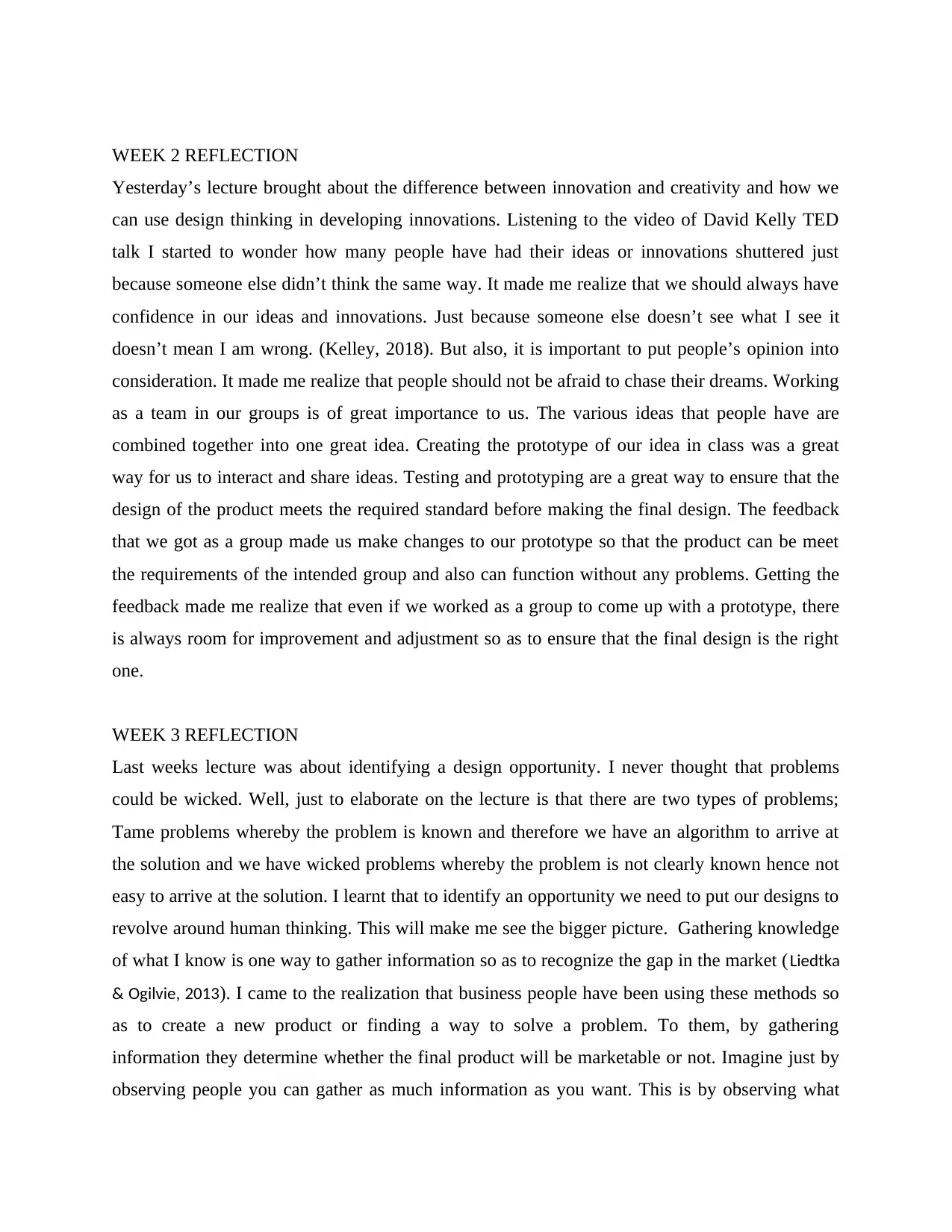
WEEK 2 REFLECTION
Yesterday’s lecture brought about the difference between innovation and creativity and how we
can use design thinking in developing innovations. Listening to the video of David Kelly TED
talk I started to wonder how many people have had their ideas or innovations shuttered just
because someone else didn’t think the same way. It made me realize that we should always have
confidence in our ideas and innovations. Just because someone else doesn’t see what I see it
doesn’t mean I am wrong. (Kelley, 2018). But also, it is important to put people’s opinion into
consideration. It made me realize that people should not be afraid to chase their dreams. Working
as a team in our groups is of great importance to us. The various ideas that people have are
combined together into one great idea. Creating the prototype of our idea in class was a great
way for us to interact and share ideas. Testing and prototyping are a great way to ensure that the
design of the product meets the required standard before making the final design. The feedback
that we got as a group made us make changes to our prototype so that the product can be meet
the requirements of the intended group and also can function without any problems. Getting the
feedback made me realize that even if we worked as a group to come up with a prototype, there
is always room for improvement and adjustment so as to ensure that the final design is the right
one.
WEEK 3 REFLECTION
Last weeks lecture was about identifying a design opportunity. I never thought that problems
could be wicked. Well, just to elaborate on the lecture is that there are two types of problems;
Tame problems whereby the problem is known and therefore we have an algorithm to arrive at
the solution and we have wicked problems whereby the problem is not clearly known hence not
easy to arrive at the solution. I learnt that to identify an opportunity we need to put our designs to
revolve around human thinking. This will make me see the bigger picture. Gathering knowledge
of what I know is one way to gather information so as to recognize the gap in the market ( Liedtka
& Ogilvie, 2013). I came to the realization that business people have been using these methods so
as to create a new product or finding a way to solve a problem. To them, by gathering
information they determine whether the final product will be marketable or not. Imagine just by
observing people you can gather as much information as you want. This is by observing what
Yesterday’s lecture brought about the difference between innovation and creativity and how we
can use design thinking in developing innovations. Listening to the video of David Kelly TED
talk I started to wonder how many people have had their ideas or innovations shuttered just
because someone else didn’t think the same way. It made me realize that we should always have
confidence in our ideas and innovations. Just because someone else doesn’t see what I see it
doesn’t mean I am wrong. (Kelley, 2018). But also, it is important to put people’s opinion into
consideration. It made me realize that people should not be afraid to chase their dreams. Working
as a team in our groups is of great importance to us. The various ideas that people have are
combined together into one great idea. Creating the prototype of our idea in class was a great
way for us to interact and share ideas. Testing and prototyping are a great way to ensure that the
design of the product meets the required standard before making the final design. The feedback
that we got as a group made us make changes to our prototype so that the product can be meet
the requirements of the intended group and also can function without any problems. Getting the
feedback made me realize that even if we worked as a group to come up with a prototype, there
is always room for improvement and adjustment so as to ensure that the final design is the right
one.
WEEK 3 REFLECTION
Last weeks lecture was about identifying a design opportunity. I never thought that problems
could be wicked. Well, just to elaborate on the lecture is that there are two types of problems;
Tame problems whereby the problem is known and therefore we have an algorithm to arrive at
the solution and we have wicked problems whereby the problem is not clearly known hence not
easy to arrive at the solution. I learnt that to identify an opportunity we need to put our designs to
revolve around human thinking. This will make me see the bigger picture. Gathering knowledge
of what I know is one way to gather information so as to recognize the gap in the market ( Liedtka
& Ogilvie, 2013). I came to the realization that business people have been using these methods so
as to create a new product or finding a way to solve a problem. To them, by gathering
information they determine whether the final product will be marketable or not. Imagine just by
observing people you can gather as much information as you want. This is by observing what
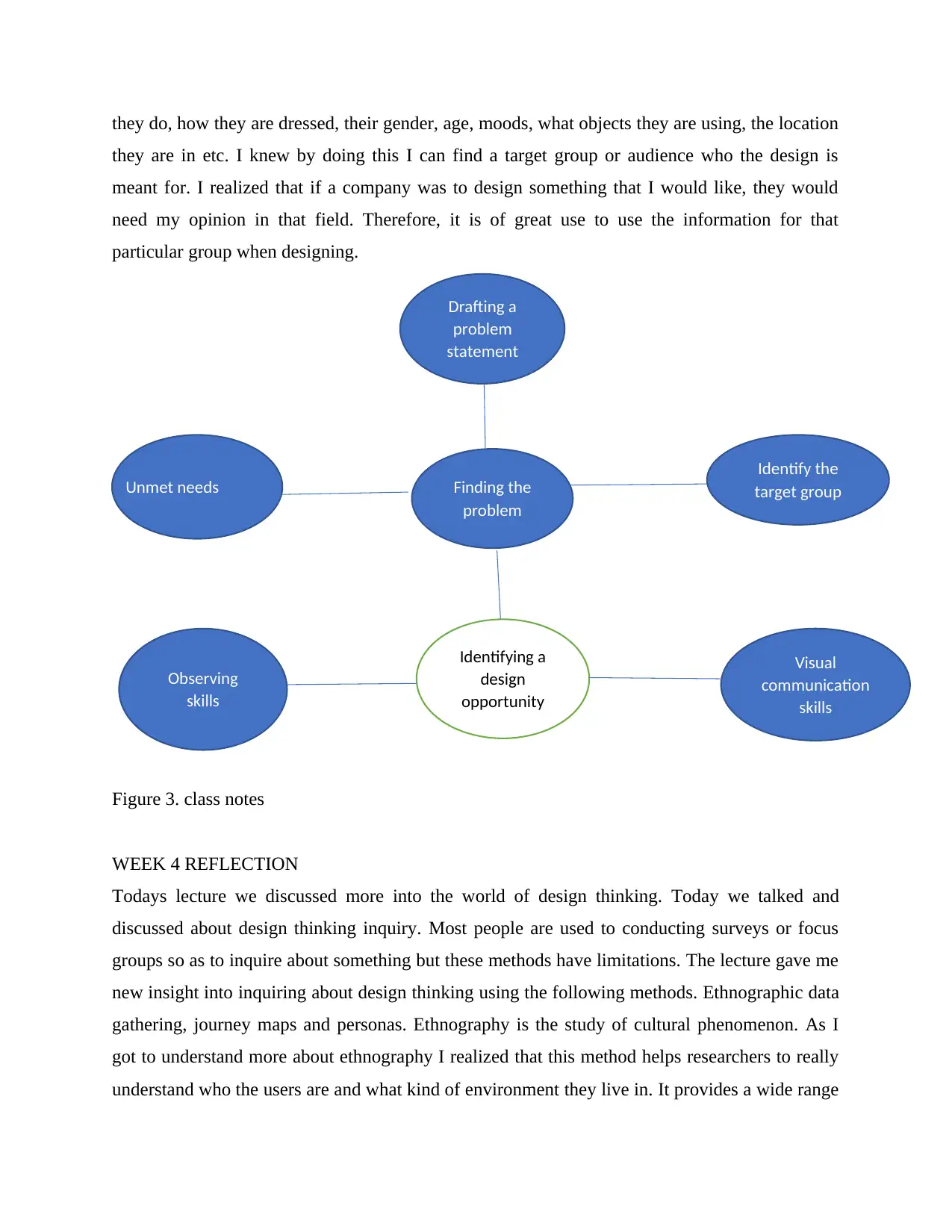
they do, how they are dressed, their gender, age, moods, what objects they are using, the location
they are in etc. I knew by doing this I can find a target group or audience who the design is
meant for. I realized that if a company was to design something that I would like, they would
need my opinion in that field. Therefore, it is of great use to use the information for that
particular group when designing.
Figure 3. class notes
WEEK 4 REFLECTION
Todays lecture we discussed more into the world of design thinking. Today we talked and
discussed about design thinking inquiry. Most people are used to conducting surveys or focus
groups so as to inquire about something but these methods have limitations. The lecture gave me
new insight into inquiring about design thinking using the following methods. Ethnographic data
gathering, journey maps and personas. Ethnography is the study of cultural phenomenon. As I
got to understand more about ethnography I realized that this method helps researchers to really
understand who the users are and what kind of environment they live in. It provides a wide range
Identifying a
design
opportunity
Finding the
problem
Identify the
target groupUnmet needs
Drafting a
problem
statement
Observing
skills
Visual
communication
skills
they are in etc. I knew by doing this I can find a target group or audience who the design is
meant for. I realized that if a company was to design something that I would like, they would
need my opinion in that field. Therefore, it is of great use to use the information for that
particular group when designing.
Figure 3. class notes
WEEK 4 REFLECTION
Todays lecture we discussed more into the world of design thinking. Today we talked and
discussed about design thinking inquiry. Most people are used to conducting surveys or focus
groups so as to inquire about something but these methods have limitations. The lecture gave me
new insight into inquiring about design thinking using the following methods. Ethnographic data
gathering, journey maps and personas. Ethnography is the study of cultural phenomenon. As I
got to understand more about ethnography I realized that this method helps researchers to really
understand who the users are and what kind of environment they live in. It provides a wide range
Identifying a
design
opportunity
Finding the
problem
Identify the
target groupUnmet needs
Drafting a
problem
statement
Observing
skills
Visual
communication
skills
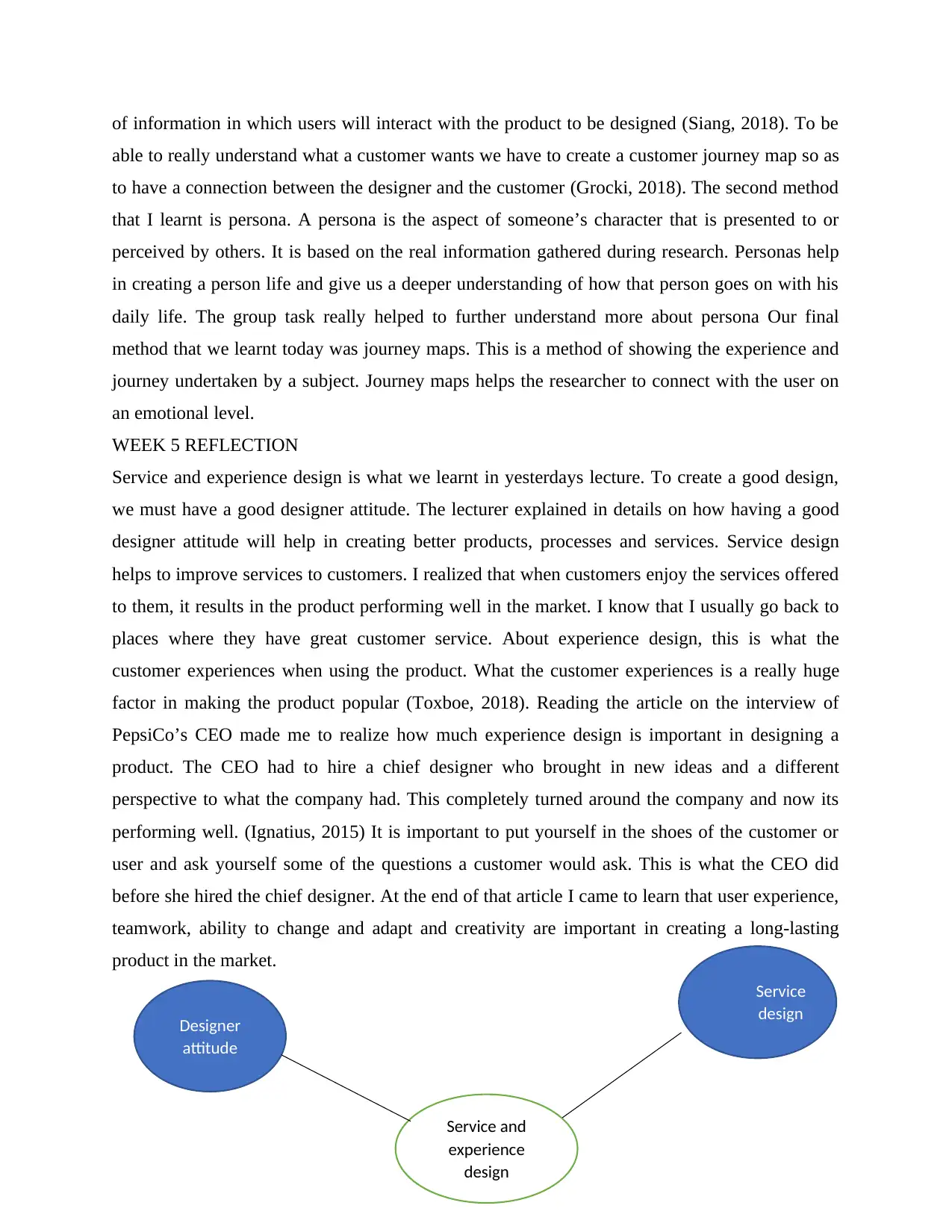
of information in which users will interact with the product to be designed (Siang, 2018). To be
able to really understand what a customer wants we have to create a customer journey map so as
to have a connection between the designer and the customer (Grocki, 2018). The second method
that I learnt is persona. A persona is the aspect of someone’s character that is presented to or
perceived by others. It is based on the real information gathered during research. Personas help
in creating a person life and give us a deeper understanding of how that person goes on with his
daily life. The group task really helped to further understand more about persona Our final
method that we learnt today was journey maps. This is a method of showing the experience and
journey undertaken by a subject. Journey maps helps the researcher to connect with the user on
an emotional level.
WEEK 5 REFLECTION
Service and experience design is what we learnt in yesterdays lecture. To create a good design,
we must have a good designer attitude. The lecturer explained in details on how having a good
designer attitude will help in creating better products, processes and services. Service design
helps to improve services to customers. I realized that when customers enjoy the services offered
to them, it results in the product performing well in the market. I know that I usually go back to
places where they have great customer service. About experience design, this is what the
customer experiences when using the product. What the customer experiences is a really huge
factor in making the product popular (Toxboe, 2018). Reading the article on the interview of
PepsiCo’s CEO made me to realize how much experience design is important in designing a
product. The CEO had to hire a chief designer who brought in new ideas and a different
perspective to what the company had. This completely turned around the company and now its
performing well. (Ignatius, 2015) It is important to put yourself in the shoes of the customer or
user and ask yourself some of the questions a customer would ask. This is what the CEO did
before she hired the chief designer. At the end of that article I came to learn that user experience,
teamwork, ability to change and adapt and creativity are important in creating a long-lasting
product in the market.
Service and
experience
design
Designer
attitude
Service
design
able to really understand what a customer wants we have to create a customer journey map so as
to have a connection between the designer and the customer (Grocki, 2018). The second method
that I learnt is persona. A persona is the aspect of someone’s character that is presented to or
perceived by others. It is based on the real information gathered during research. Personas help
in creating a person life and give us a deeper understanding of how that person goes on with his
daily life. The group task really helped to further understand more about persona Our final
method that we learnt today was journey maps. This is a method of showing the experience and
journey undertaken by a subject. Journey maps helps the researcher to connect with the user on
an emotional level.
WEEK 5 REFLECTION
Service and experience design is what we learnt in yesterdays lecture. To create a good design,
we must have a good designer attitude. The lecturer explained in details on how having a good
designer attitude will help in creating better products, processes and services. Service design
helps to improve services to customers. I realized that when customers enjoy the services offered
to them, it results in the product performing well in the market. I know that I usually go back to
places where they have great customer service. About experience design, this is what the
customer experiences when using the product. What the customer experiences is a really huge
factor in making the product popular (Toxboe, 2018). Reading the article on the interview of
PepsiCo’s CEO made me to realize how much experience design is important in designing a
product. The CEO had to hire a chief designer who brought in new ideas and a different
perspective to what the company had. This completely turned around the company and now its
performing well. (Ignatius, 2015) It is important to put yourself in the shoes of the customer or
user and ask yourself some of the questions a customer would ask. This is what the CEO did
before she hired the chief designer. At the end of that article I came to learn that user experience,
teamwork, ability to change and adapt and creativity are important in creating a long-lasting
product in the market.
Service and
experience
design
Designer
attitude
Service
design
Secure Best Marks with AI Grader
Need help grading? Try our AI Grader for instant feedback on your assignments.
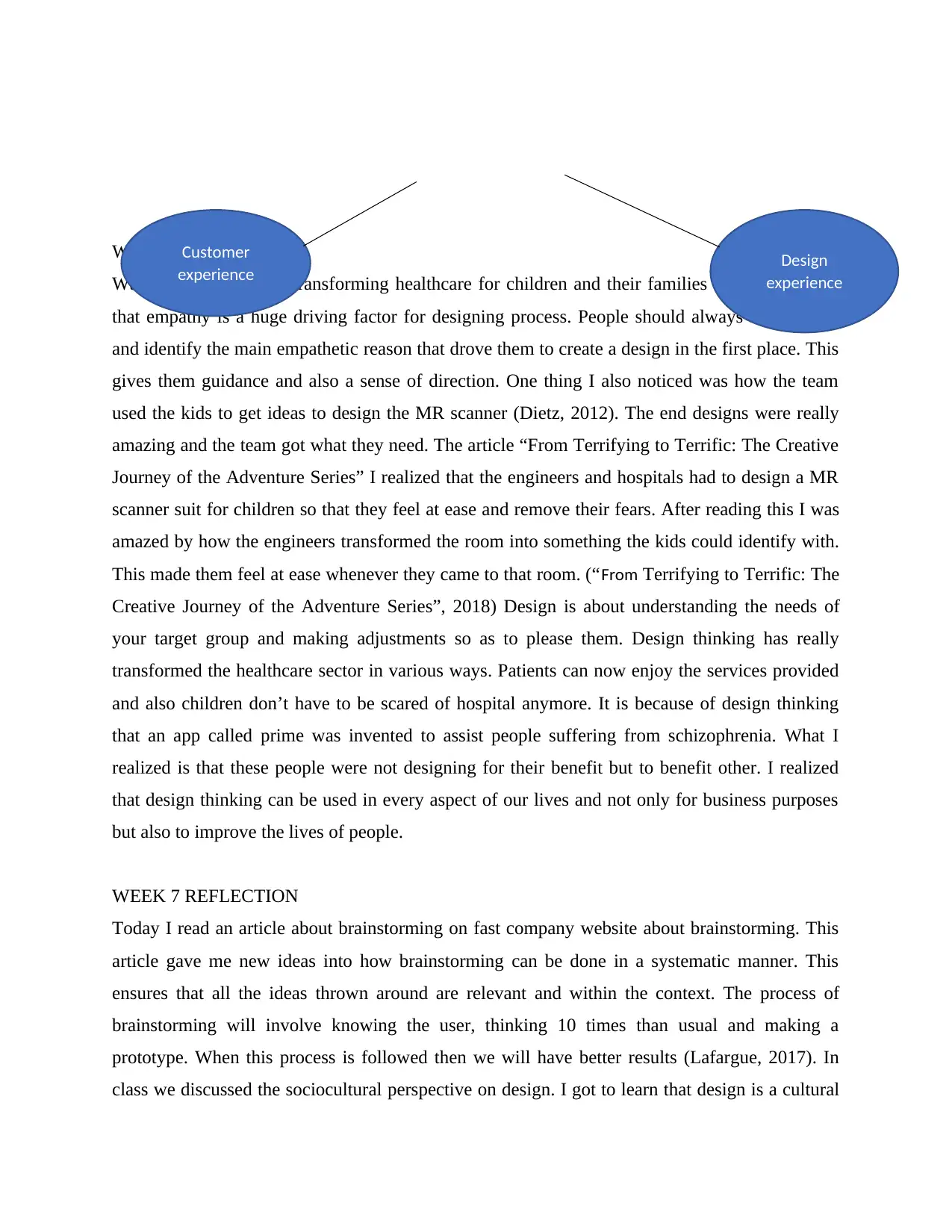
WEEK 6 REFLECTION
Watching the video on transforming healthcare for children and their families made me realize
that empathy is a huge driving factor for designing process. People should always reflect back
and identify the main empathetic reason that drove them to create a design in the first place. This
gives them guidance and also a sense of direction. One thing I also noticed was how the team
used the kids to get ideas to design the MR scanner (Dietz, 2012). The end designs were really
amazing and the team got what they need. The article “From Terrifying to Terrific: The Creative
Journey of the Adventure Series” I realized that the engineers and hospitals had to design a MR
scanner suit for children so that they feel at ease and remove their fears. After reading this I was
amazed by how the engineers transformed the room into something the kids could identify with.
This made them feel at ease whenever they came to that room. (“From Terrifying to Terrific: The
Creative Journey of the Adventure Series”, 2018) Design is about understanding the needs of
your target group and making adjustments so as to please them. Design thinking has really
transformed the healthcare sector in various ways. Patients can now enjoy the services provided
and also children don’t have to be scared of hospital anymore. It is because of design thinking
that an app called prime was invented to assist people suffering from schizophrenia. What I
realized is that these people were not designing for their benefit but to benefit other. I realized
that design thinking can be used in every aspect of our lives and not only for business purposes
but also to improve the lives of people.
WEEK 7 REFLECTION
Today I read an article about brainstorming on fast company website about brainstorming. This
article gave me new ideas into how brainstorming can be done in a systematic manner. This
ensures that all the ideas thrown around are relevant and within the context. The process of
brainstorming will involve knowing the user, thinking 10 times than usual and making a
prototype. When this process is followed then we will have better results (Lafargue, 2017). In
class we discussed the sociocultural perspective on design. I got to learn that design is a cultural
Customer
experience Design
experience
Watching the video on transforming healthcare for children and their families made me realize
that empathy is a huge driving factor for designing process. People should always reflect back
and identify the main empathetic reason that drove them to create a design in the first place. This
gives them guidance and also a sense of direction. One thing I also noticed was how the team
used the kids to get ideas to design the MR scanner (Dietz, 2012). The end designs were really
amazing and the team got what they need. The article “From Terrifying to Terrific: The Creative
Journey of the Adventure Series” I realized that the engineers and hospitals had to design a MR
scanner suit for children so that they feel at ease and remove their fears. After reading this I was
amazed by how the engineers transformed the room into something the kids could identify with.
This made them feel at ease whenever they came to that room. (“From Terrifying to Terrific: The
Creative Journey of the Adventure Series”, 2018) Design is about understanding the needs of
your target group and making adjustments so as to please them. Design thinking has really
transformed the healthcare sector in various ways. Patients can now enjoy the services provided
and also children don’t have to be scared of hospital anymore. It is because of design thinking
that an app called prime was invented to assist people suffering from schizophrenia. What I
realized is that these people were not designing for their benefit but to benefit other. I realized
that design thinking can be used in every aspect of our lives and not only for business purposes
but also to improve the lives of people.
WEEK 7 REFLECTION
Today I read an article about brainstorming on fast company website about brainstorming. This
article gave me new ideas into how brainstorming can be done in a systematic manner. This
ensures that all the ideas thrown around are relevant and within the context. The process of
brainstorming will involve knowing the user, thinking 10 times than usual and making a
prototype. When this process is followed then we will have better results (Lafargue, 2017). In
class we discussed the sociocultural perspective on design. I got to learn that design is a cultural
Customer
experience Design
experience
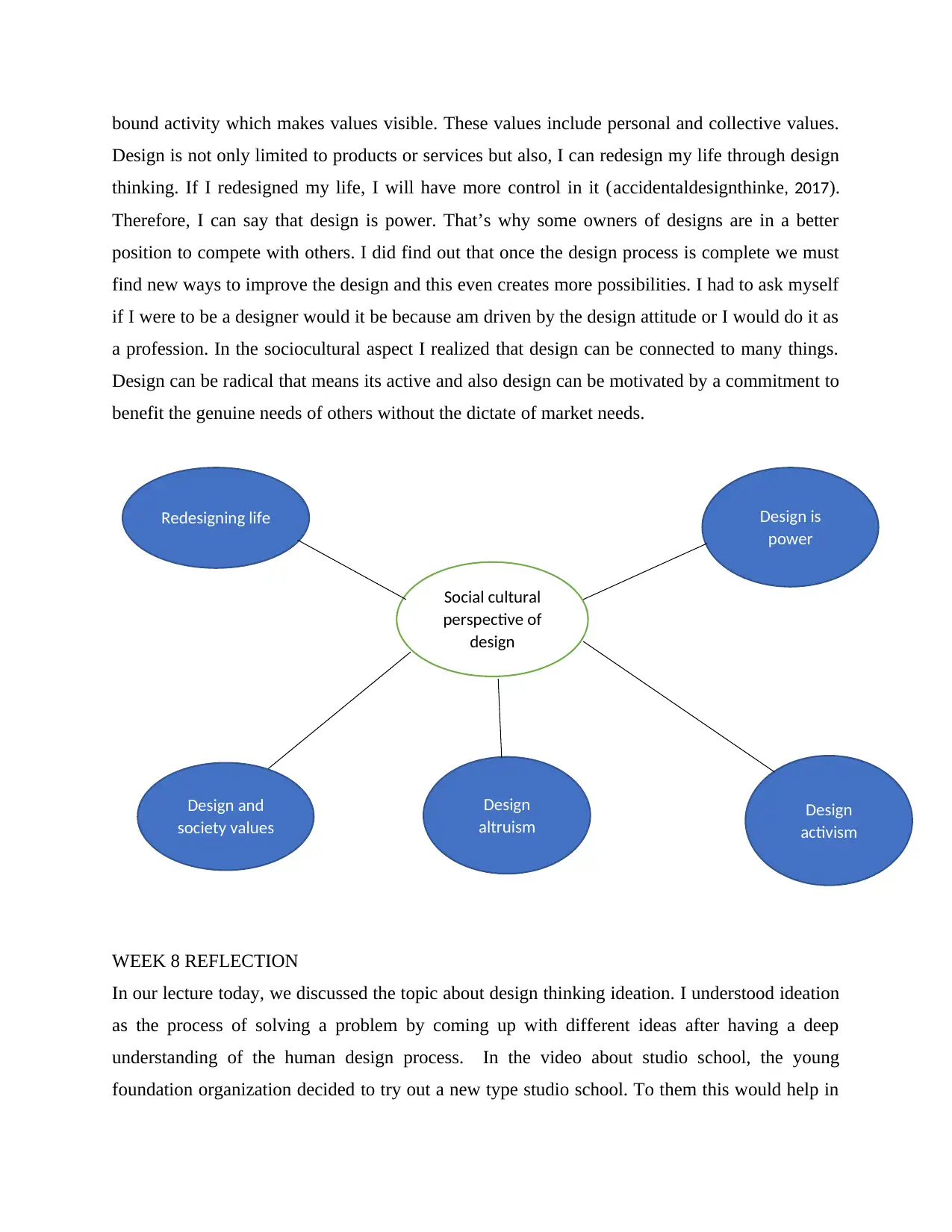
bound activity which makes values visible. These values include personal and collective values.
Design is not only limited to products or services but also, I can redesign my life through design
thinking. If I redesigned my life, I will have more control in it (accidentaldesignthinke, 2017).
Therefore, I can say that design is power. That’s why some owners of designs are in a better
position to compete with others. I did find out that once the design process is complete we must
find new ways to improve the design and this even creates more possibilities. I had to ask myself
if I were to be a designer would it be because am driven by the design attitude or I would do it as
a profession. In the sociocultural aspect I realized that design can be connected to many things.
Design can be radical that means its active and also design can be motivated by a commitment to
benefit the genuine needs of others without the dictate of market needs.
WEEK 8 REFLECTION
In our lecture today, we discussed the topic about design thinking ideation. I understood ideation
as the process of solving a problem by coming up with different ideas after having a deep
understanding of the human design process. In the video about studio school, the young
foundation organization decided to try out a new type studio school. To them this would help in
Social cultural
perspective of
design
Redesigning life Design is
power
Design and
society values
Design
altruism
Design
activism
Design is not only limited to products or services but also, I can redesign my life through design
thinking. If I redesigned my life, I will have more control in it (accidentaldesignthinke, 2017).
Therefore, I can say that design is power. That’s why some owners of designs are in a better
position to compete with others. I did find out that once the design process is complete we must
find new ways to improve the design and this even creates more possibilities. I had to ask myself
if I were to be a designer would it be because am driven by the design attitude or I would do it as
a profession. In the sociocultural aspect I realized that design can be connected to many things.
Design can be radical that means its active and also design can be motivated by a commitment to
benefit the genuine needs of others without the dictate of market needs.
WEEK 8 REFLECTION
In our lecture today, we discussed the topic about design thinking ideation. I understood ideation
as the process of solving a problem by coming up with different ideas after having a deep
understanding of the human design process. In the video about studio school, the young
foundation organization decided to try out a new type studio school. To them this would help in
Social cultural
perspective of
design
Redesigning life Design is
power
Design and
society values
Design
altruism
Design
activism
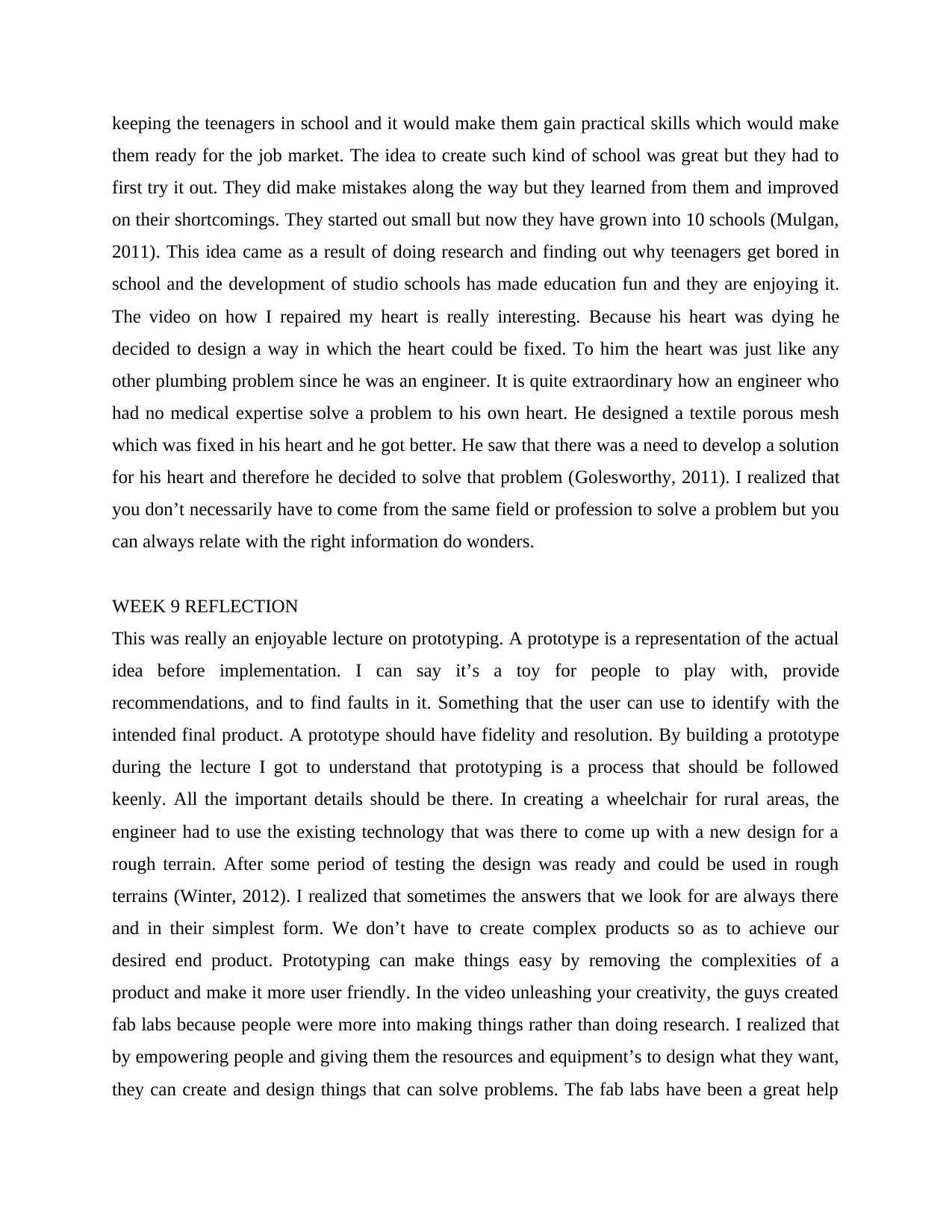
keeping the teenagers in school and it would make them gain practical skills which would make
them ready for the job market. The idea to create such kind of school was great but they had to
first try it out. They did make mistakes along the way but they learned from them and improved
on their shortcomings. They started out small but now they have grown into 10 schools (Mulgan,
2011). This idea came as a result of doing research and finding out why teenagers get bored in
school and the development of studio schools has made education fun and they are enjoying it.
The video on how I repaired my heart is really interesting. Because his heart was dying he
decided to design a way in which the heart could be fixed. To him the heart was just like any
other plumbing problem since he was an engineer. It is quite extraordinary how an engineer who
had no medical expertise solve a problem to his own heart. He designed a textile porous mesh
which was fixed in his heart and he got better. He saw that there was a need to develop a solution
for his heart and therefore he decided to solve that problem (Golesworthy, 2011). I realized that
you don’t necessarily have to come from the same field or profession to solve a problem but you
can always relate with the right information do wonders.
WEEK 9 REFLECTION
This was really an enjoyable lecture on prototyping. A prototype is a representation of the actual
idea before implementation. I can say it’s a toy for people to play with, provide
recommendations, and to find faults in it. Something that the user can use to identify with the
intended final product. A prototype should have fidelity and resolution. By building a prototype
during the lecture I got to understand that prototyping is a process that should be followed
keenly. All the important details should be there. In creating a wheelchair for rural areas, the
engineer had to use the existing technology that was there to come up with a new design for a
rough terrain. After some period of testing the design was ready and could be used in rough
terrains (Winter, 2012). I realized that sometimes the answers that we look for are always there
and in their simplest form. We don’t have to create complex products so as to achieve our
desired end product. Prototyping can make things easy by removing the complexities of a
product and make it more user friendly. In the video unleashing your creativity, the guys created
fab labs because people were more into making things rather than doing research. I realized that
by empowering people and giving them the resources and equipment’s to design what they want,
they can create and design things that can solve problems. The fab labs have been a great help
them ready for the job market. The idea to create such kind of school was great but they had to
first try it out. They did make mistakes along the way but they learned from them and improved
on their shortcomings. They started out small but now they have grown into 10 schools (Mulgan,
2011). This idea came as a result of doing research and finding out why teenagers get bored in
school and the development of studio schools has made education fun and they are enjoying it.
The video on how I repaired my heart is really interesting. Because his heart was dying he
decided to design a way in which the heart could be fixed. To him the heart was just like any
other plumbing problem since he was an engineer. It is quite extraordinary how an engineer who
had no medical expertise solve a problem to his own heart. He designed a textile porous mesh
which was fixed in his heart and he got better. He saw that there was a need to develop a solution
for his heart and therefore he decided to solve that problem (Golesworthy, 2011). I realized that
you don’t necessarily have to come from the same field or profession to solve a problem but you
can always relate with the right information do wonders.
WEEK 9 REFLECTION
This was really an enjoyable lecture on prototyping. A prototype is a representation of the actual
idea before implementation. I can say it’s a toy for people to play with, provide
recommendations, and to find faults in it. Something that the user can use to identify with the
intended final product. A prototype should have fidelity and resolution. By building a prototype
during the lecture I got to understand that prototyping is a process that should be followed
keenly. All the important details should be there. In creating a wheelchair for rural areas, the
engineer had to use the existing technology that was there to come up with a new design for a
rough terrain. After some period of testing the design was ready and could be used in rough
terrains (Winter, 2012). I realized that sometimes the answers that we look for are always there
and in their simplest form. We don’t have to create complex products so as to achieve our
desired end product. Prototyping can make things easy by removing the complexities of a
product and make it more user friendly. In the video unleashing your creativity, the guys created
fab labs because people were more into making things rather than doing research. I realized that
by empowering people and giving them the resources and equipment’s to design what they want,
they can create and design things that can solve problems. The fab labs have been a great help
Paraphrase This Document
Need a fresh take? Get an instant paraphrase of this document with our AI Paraphraser
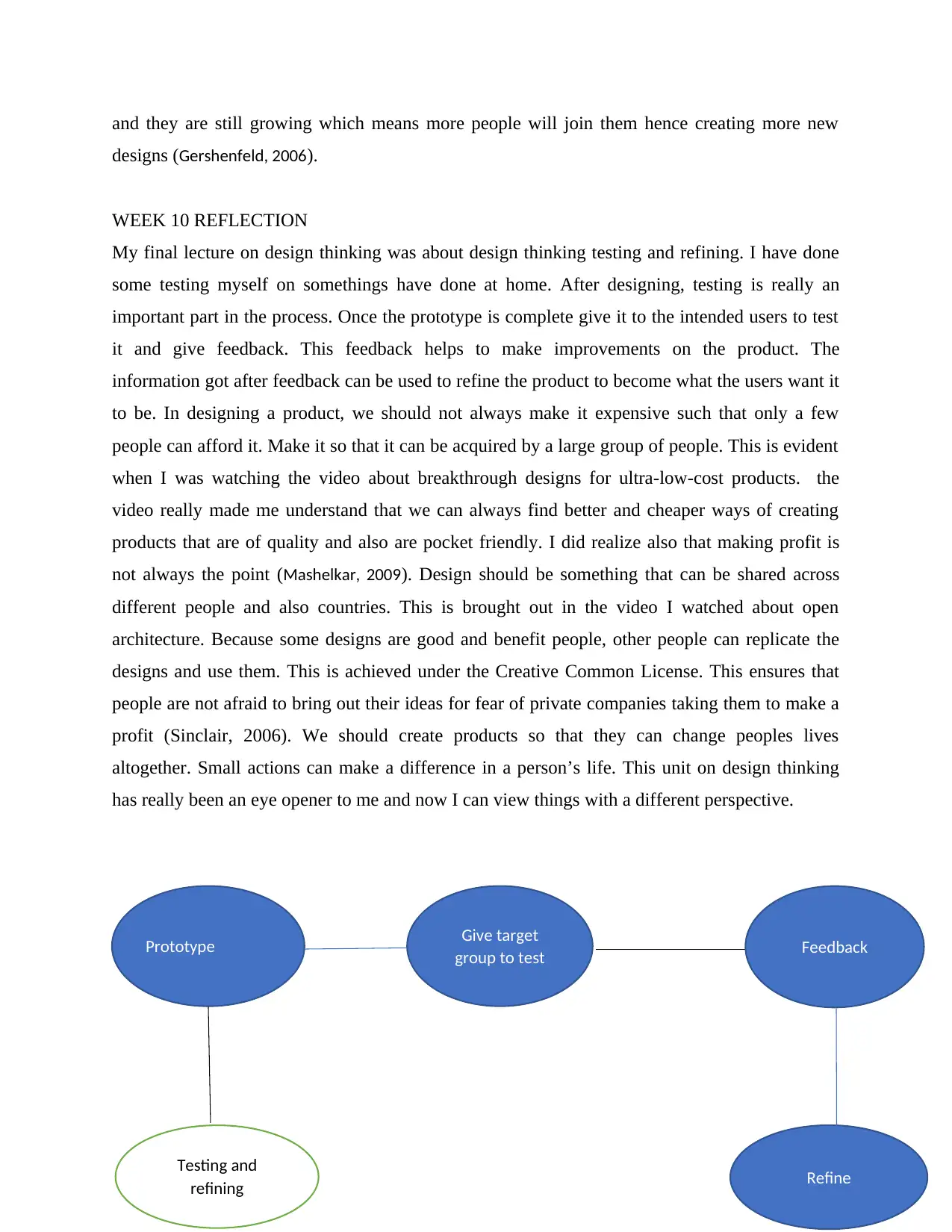
and they are still growing which means more people will join them hence creating more new
designs (Gershenfeld, 2006).
WEEK 10 REFLECTION
My final lecture on design thinking was about design thinking testing and refining. I have done
some testing myself on somethings have done at home. After designing, testing is really an
important part in the process. Once the prototype is complete give it to the intended users to test
it and give feedback. This feedback helps to make improvements on the product. The
information got after feedback can be used to refine the product to become what the users want it
to be. In designing a product, we should not always make it expensive such that only a few
people can afford it. Make it so that it can be acquired by a large group of people. This is evident
when I was watching the video about breakthrough designs for ultra-low-cost products. the
video really made me understand that we can always find better and cheaper ways of creating
products that are of quality and also are pocket friendly. I did realize also that making profit is
not always the point (Mashelkar, 2009). Design should be something that can be shared across
different people and also countries. This is brought out in the video I watched about open
architecture. Because some designs are good and benefit people, other people can replicate the
designs and use them. This is achieved under the Creative Common License. This ensures that
people are not afraid to bring out their ideas for fear of private companies taking them to make a
profit (Sinclair, 2006). We should create products so that they can change peoples lives
altogether. Small actions can make a difference in a person’s life. This unit on design thinking
has really been an eye opener to me and now I can view things with a different perspective.
Testing and
refining
Prototype Give target
group to test
Refine
Feedback
designs (Gershenfeld, 2006).
WEEK 10 REFLECTION
My final lecture on design thinking was about design thinking testing and refining. I have done
some testing myself on somethings have done at home. After designing, testing is really an
important part in the process. Once the prototype is complete give it to the intended users to test
it and give feedback. This feedback helps to make improvements on the product. The
information got after feedback can be used to refine the product to become what the users want it
to be. In designing a product, we should not always make it expensive such that only a few
people can afford it. Make it so that it can be acquired by a large group of people. This is evident
when I was watching the video about breakthrough designs for ultra-low-cost products. the
video really made me understand that we can always find better and cheaper ways of creating
products that are of quality and also are pocket friendly. I did realize also that making profit is
not always the point (Mashelkar, 2009). Design should be something that can be shared across
different people and also countries. This is brought out in the video I watched about open
architecture. Because some designs are good and benefit people, other people can replicate the
designs and use them. This is achieved under the Creative Common License. This ensures that
people are not afraid to bring out their ideas for fear of private companies taking them to make a
profit (Sinclair, 2006). We should create products so that they can change peoples lives
altogether. Small actions can make a difference in a person’s life. This unit on design thinking
has really been an eye opener to me and now I can view things with a different perspective.
Testing and
refining
Prototype Give target
group to test
Refine
Feedback

Figure 5. class notes
REFERENCES
Brown, T. (2018). Tim Brown urges designers to think big. Retrieved from
https://www.youtube.com/watch?v=UAinLaT42xY&feature=youtu.bee
Nussbaum, B. (2018). Design Thinking Is A Failed Experiment. So What’s Next?. Retrieved from
http://www.fastcodesign.com/1663558/design-thinking-is-a-failed-experiment-so-whats-next
Mc Cracken, G. (2018). Is Design Thinking Dead? Hell No. Retrieved from
http://www.fastcodesign.com/1665384/is-design-thinking-dead-hell-no
Kelley, D. (2018). How to build your creative confidence | David Kelley. Retrieved from
https://www.youtube.com/watch?v=16p9YRF0l-g
Pecknold, K. (2018). TEDxVancouver - Kara Pecknold - Design is the centre of change. Retrieved from
http://www.youtube.com/watch?v=FjnGdiqk96Y
Liedtka, J., & Ogilvie, T. (2013). Designing for growth (p. chapter 2). New York: Columbia University
Press.
Design Kit: The Human-Centered Design Toolkit. (2018). Retrieved from
http://www.ideo.com/work/human-centered-design-toolkit/
How design thinking transformed Airbnb from failing startup to billion-dollar business. (2018). Retrieved
from https://www.youtube.com/watch?
v=RUEjYswwWPY&t=0s&list=PLg_9VubxjUNOvzUFvIOnqs9Q_Ri93jJSz&index=1
Ignatius, a. (2015). How Indra Nooyi Turned Design Thinking Into Strategy: An Interview with PepsiCo’s
CEO. Retrieved from https://hbr.org/2015/09/how-indra-nooyi-turned-design-thinking-into-strategy
Toxboe, A. (2018). Applying Design Thinking at the Organizational Level at Uber. Retrieved from
http://talks.ui-patterns.com/videos/applying-design-thinking-at-the-organizational-level-uber-amritha-
prasad
Dietz, D. (2012). Transforming healthcare for children and their families: Doug Dietz at TEDxSanJoseCA
2012. Retrieved from https://www.youtube.com/watch?v=jajduxPD6H4
From Terrifying to Terrific: The Creative Journey of the Adventure Series. (2012). Retrieved from
http://newsroom.gehealthcare.com/from-terrifying-to-terrific-creative-journey-of-the-adventure-series/
REFERENCES
Brown, T. (2018). Tim Brown urges designers to think big. Retrieved from
https://www.youtube.com/watch?v=UAinLaT42xY&feature=youtu.bee
Nussbaum, B. (2018). Design Thinking Is A Failed Experiment. So What’s Next?. Retrieved from
http://www.fastcodesign.com/1663558/design-thinking-is-a-failed-experiment-so-whats-next
Mc Cracken, G. (2018). Is Design Thinking Dead? Hell No. Retrieved from
http://www.fastcodesign.com/1665384/is-design-thinking-dead-hell-no
Kelley, D. (2018). How to build your creative confidence | David Kelley. Retrieved from
https://www.youtube.com/watch?v=16p9YRF0l-g
Pecknold, K. (2018). TEDxVancouver - Kara Pecknold - Design is the centre of change. Retrieved from
http://www.youtube.com/watch?v=FjnGdiqk96Y
Liedtka, J., & Ogilvie, T. (2013). Designing for growth (p. chapter 2). New York: Columbia University
Press.
Design Kit: The Human-Centered Design Toolkit. (2018). Retrieved from
http://www.ideo.com/work/human-centered-design-toolkit/
How design thinking transformed Airbnb from failing startup to billion-dollar business. (2018). Retrieved
from https://www.youtube.com/watch?
v=RUEjYswwWPY&t=0s&list=PLg_9VubxjUNOvzUFvIOnqs9Q_Ri93jJSz&index=1
Ignatius, a. (2015). How Indra Nooyi Turned Design Thinking Into Strategy: An Interview with PepsiCo’s
CEO. Retrieved from https://hbr.org/2015/09/how-indra-nooyi-turned-design-thinking-into-strategy
Toxboe, A. (2018). Applying Design Thinking at the Organizational Level at Uber. Retrieved from
http://talks.ui-patterns.com/videos/applying-design-thinking-at-the-organizational-level-uber-amritha-
prasad
Dietz, D. (2012). Transforming healthcare for children and their families: Doug Dietz at TEDxSanJoseCA
2012. Retrieved from https://www.youtube.com/watch?v=jajduxPD6H4
From Terrifying to Terrific: The Creative Journey of the Adventure Series. (2012). Retrieved from
http://newsroom.gehealthcare.com/from-terrifying-to-terrific-creative-journey-of-the-adventure-series/
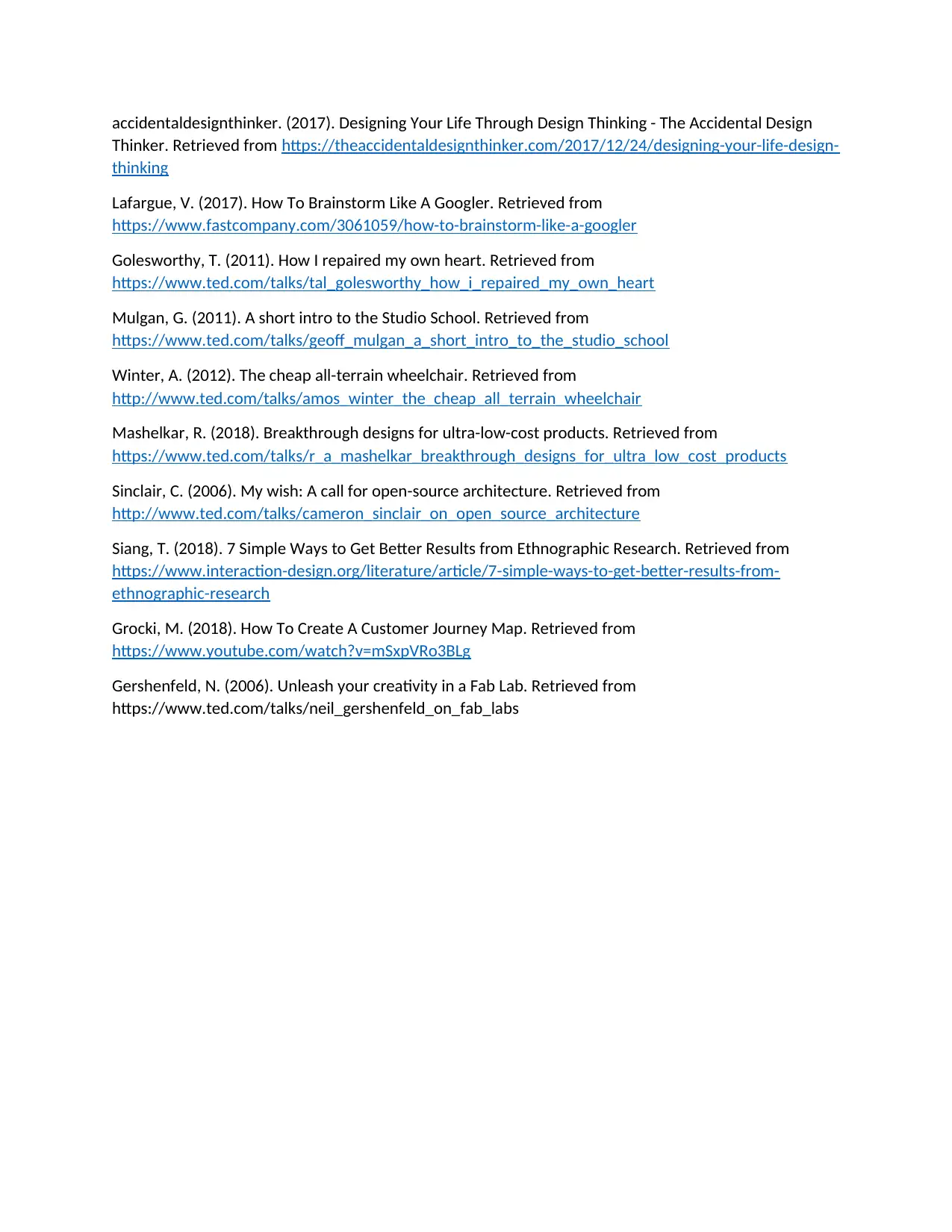
accidentaldesignthinker. (2017). Designing Your Life Through Design Thinking - The Accidental Design
Thinker. Retrieved from https://theaccidentaldesignthinker.com/2017/12/24/designing-your-life-design-
thinking
Lafargue, V. (2017). How To Brainstorm Like A Googler. Retrieved from
https://www.fastcompany.com/3061059/how-to-brainstorm-like-a-googler
Golesworthy, T. (2011). How I repaired my own heart. Retrieved from
https://www.ted.com/talks/tal_golesworthy_how_i_repaired_my_own_heart
Mulgan, G. (2011). A short intro to the Studio School. Retrieved from
https://www.ted.com/talks/geoff_mulgan_a_short_intro_to_the_studio_school
Winter, A. (2012). The cheap all-terrain wheelchair. Retrieved from
http://www.ted.com/talks/amos_winter_the_cheap_all_terrain_wheelchair
Mashelkar, R. (2018). Breakthrough designs for ultra-low-cost products. Retrieved from
https://www.ted.com/talks/r_a_mashelkar_breakthrough_designs_for_ultra_low_cost_products
Sinclair, C. (2006). My wish: A call for open-source architecture. Retrieved from
http://www.ted.com/talks/cameron_sinclair_on_open_source_architecture
Siang, T. (2018). 7 Simple Ways to Get Better Results from Ethnographic Research. Retrieved from
https://www.interaction-design.org/literature/article/7-simple-ways-to-get-better-results-from-
ethnographic-research
Grocki, M. (2018). How To Create A Customer Journey Map. Retrieved from
https://www.youtube.com/watch?v=mSxpVRo3BLg
Gershenfeld, N. (2006). Unleash your creativity in a Fab Lab. Retrieved from
https://www.ted.com/talks/neil_gershenfeld_on_fab_labs
Thinker. Retrieved from https://theaccidentaldesignthinker.com/2017/12/24/designing-your-life-design-
thinking
Lafargue, V. (2017). How To Brainstorm Like A Googler. Retrieved from
https://www.fastcompany.com/3061059/how-to-brainstorm-like-a-googler
Golesworthy, T. (2011). How I repaired my own heart. Retrieved from
https://www.ted.com/talks/tal_golesworthy_how_i_repaired_my_own_heart
Mulgan, G. (2011). A short intro to the Studio School. Retrieved from
https://www.ted.com/talks/geoff_mulgan_a_short_intro_to_the_studio_school
Winter, A. (2012). The cheap all-terrain wheelchair. Retrieved from
http://www.ted.com/talks/amos_winter_the_cheap_all_terrain_wheelchair
Mashelkar, R. (2018). Breakthrough designs for ultra-low-cost products. Retrieved from
https://www.ted.com/talks/r_a_mashelkar_breakthrough_designs_for_ultra_low_cost_products
Sinclair, C. (2006). My wish: A call for open-source architecture. Retrieved from
http://www.ted.com/talks/cameron_sinclair_on_open_source_architecture
Siang, T. (2018). 7 Simple Ways to Get Better Results from Ethnographic Research. Retrieved from
https://www.interaction-design.org/literature/article/7-simple-ways-to-get-better-results-from-
ethnographic-research
Grocki, M. (2018). How To Create A Customer Journey Map. Retrieved from
https://www.youtube.com/watch?v=mSxpVRo3BLg
Gershenfeld, N. (2006). Unleash your creativity in a Fab Lab. Retrieved from
https://www.ted.com/talks/neil_gershenfeld_on_fab_labs
1 out of 10
Related Documents
Your All-in-One AI-Powered Toolkit for Academic Success.
+13062052269
info@desklib.com
Available 24*7 on WhatsApp / Email
![[object Object]](/_next/static/media/star-bottom.7253800d.svg)
Unlock your academic potential
© 2024 | Zucol Services PVT LTD | All rights reserved.




